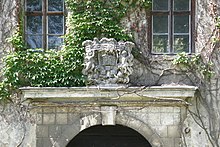Hackenberg (Lower Austrian noble family)


Hackenberg (also lords of Hackenberg, Hagenberg, Hakenberg, Hackenperch, Haggenberg ) is the name of a Lower Austrian noble family that descended from Azzo von Gobatsburg . They were therefore related to the Kuenringer and appear with them on numerous deed of gifts and purchase. They were Austrian ministerials (followers of the regional princes) and first appeared in a document in Lower Austria in 1180 . Her ancestral home was the Hagenberg Castle (Fallbach) of the same name .
history
The family was first mentioned in a document in 1180 with Otto de Hakkenperch . He is mentioned as a witness of a handover letter to the Neuburg Monastery, today's Klosterneuburg Monastery . His wife Jutha von Hakkenperch also appears on a document in 1200.
Presumably his son Heinrich I von Hackenperch appears in the letter of mortgage in 1220, in which Duke Friedrich the Mighty granted a fiefdom to a Konrad von Hintperch as a treasurer in Austria. The minstrel and poet Ulrich von Liechtenstein wrote the following lines about him: “In the morning I crossed the Danube and rode towards Korneuburg, where a hundred knights were waiting for me, eager to receive me with dignity. It was still early - there was a nice knight's game. ”(…)“ Heinrich von Hackenberg was the next, a poor nobleman who achieved great fame. Because he was not only brave, but also wise. ”Heinrich von Hackenberg played a leading role in the Damiette crusade .
One or two generations later, a descendant of Chunradus (Konrad von Hackenberg) became Commander of Mailberg between 1289 and 1293 and representative of the Order's Grand Master of the Johanniter . His brother, Otto II von Hackenberg (Hagenberg) , acquired the rulership of Rabensburg in 1294 , which was then conquered by King John of Bohemia in 1328 . Also in 1294, Otto von Hackenberg certified that he and his wife Hedwig and their children were selling their estate in Klaubendorf to the Zwettl monastery .
In 1295 the same Otto von Hackenberg took an active part in the uprising of the nobility against Albrecht I (HRR) and was sent with Heinrich II of Liechtenstein to King Wenceslaus II (Bohemia) to ask for help, which King Wenceslaus II in the end promised in writing.
Marquard von Hakenberg , also a son of Otto, died in 1319 and was buried in the Katharinenkapelle of the Minoritenkirche (Vienna) . At that time nobles were buried there who had made special contributions to the royal court administration. Their coats of arms were attached to the walls of the church interior, which is why the original coat of arms of those of Hackenberg has been preserved.
In a certificate from Karl IV. (HRR) dated July 10, 1355 for the citizens of Regensburg "about the permission to levy Ungelt (customs) on all food" Heinrich V. von Hackenberg is named as a witness. In a dispute between the Mainz cathedral chapter and Charles IV over the Oppenheim pledge, the court master of Rudolf IV (Austria) , the knight Heinrich von Hackenberg , was appointed as a royal, “special messenger” in August 1357. In 1381 Heinrich is mentioned on the marriage contract with his wife Kunigunde, a daughter of Hartneid II, Lord of Liechtenstein, Nikolsburg and Eisgrub .
coat of arms
Blazon : The coat of arms shows a silver barb on a black background .
According to Johann Siebmacher : A silver hoe set up in black shields; Two buffalo horns placed on the helmet, each set on the outside with 7 bay leaves and wrapped with a silver ribbon; the helmet covers are silver and black.
literature
- Johann Evang. Kirnbauer von Erzstätt : The Lower Austrian rural nobility. Panels, A – R. In: J. Siebmacher's large and general book of arms . Volume 4. Bauer and Raspe, Nuremberg 1909, plate 75.
- Johann Evang. Kirnbauer von Erzstätt: The Lower Austrian rural nobility. Text, A – R. In: J. Siebmacher's large and general book of arms . Volume 4. Bauer and Raspe, Nuremberg 1909, 150–151.
- Georg Clam Martinic : Castles and palaces in Austria - from Vorarlberg to Burgenland . Verlag A and M, St. Pölten / Vienna / Linz 1991, 506 pages.
Individual evidence
- ↑ Document: Documents Klosterneuburg (1002-1767) 1248 VII 05 , accessed on February 19, 2019
- ↑ The scene of the local Lower Austrian nobility , accessed on February 19, 2019
- ↑ Ulrich von Lichtenstein: The minnesinger's women's service - Chapter 12 , accessed on February 19, 2019
- ↑ Wina magazine, The Jewish city magazine. Issue 11. Vol. Nov. 2016 - Chapter MEMORIES & Thoughts By Ronnie Niedermeyer , accessed on February 19, 2019
- ↑ Handbook of the History of the Duchy of Carinthia: Von der ..., Volume 2 , accessed on February 19, 2019
- ↑ Non-Bohemian Medieval Original Documents in the Bohemian Lands, Volume 1, page 111 , accessed on February 19, 2019
- ^ The Lords of Kuenring: A contribution to the aristocratic history of the Archduchy of Austria, S LVII , accessed on February 19, 2019
- ^ The Lords of Kuenring: A contribution to the aristocratic history of the Archduchy of Austria, p.118 , accessed on February 19, 2019
- ^ History of the cadastral community of Hagenberg , accessed on February 19, 2019
- ↑ Regestendatenbank - Charles IV -. [RIplus Regg. Charles IV. (Diplomas) [n. 3093]], accessed February 5, 2020
- ^ Regestdatenbank - Archbishops of Mainz - Dept. 2, Vol. 1, n. 867 , accessed on February 5, 2020
- ↑ Personal data Kunigunde Von Liechtenstein , accessed on February 19, 2019
- ↑ The bourgeoisie in the heraldry of the Vienna Minorite Church Diploma thesis Monika Sollmann , accessed on February 19, 2019
- ↑ Document: Imbach, Dominikanerinnen (1267-1764) 1330 VII 12 - Seal of Leutold von Hagenberg , accessed on February 19, 2019
